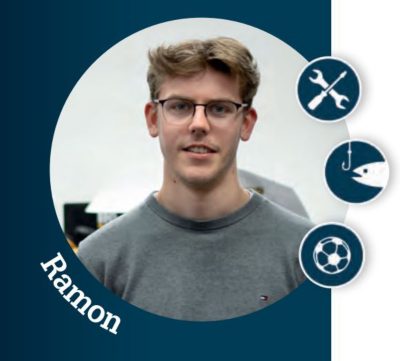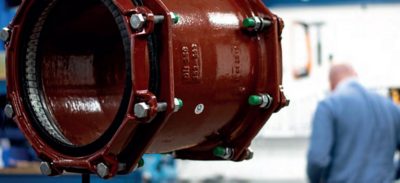More than two years have passed since that moment, and the new Big 5 project (DN625 – DN825) is now ready to serve customers with their water application challenges. Looking back on these past years, R&D manager Michel Hulsebos is telling us about the ups and downs, the technical pitfalls, ‘eureka’ moments, and how team members worked together like never before.
Technical feasibility
For R&D, the ‘can we go any bigger’ turned soon into: ‘is it technically feasible?’ “We started the Big 5 project by separating the things that were clear to us and the things that were not. That resulted in three important questions for us. ‘Is it even possible to make such big sizes in ductile cast iron?’ ‘Could we use the design of our MULTI/JOINT® DN425 – DN600 to use it for these new dimensions? And, ‘can we think of something that could have a positive effect on investments and delivery time?” Tells Michel. Although the MULTI/JOINT® ‘just’ needed to get bigger, it was anything but ‘copy and paste’ for the development team.
“You cannot scale up everything that easily. This is because forces increase to the power of two, and volumes increase to the power of three. If diameters get twice as big, forces will be four times bigger and the volumes eight times as big,” Michel explains. “A bee can fly, not only because he has wings, but also due to his small size and light weight. However, if you would make the same bee twice as big, It would not be so obvious anymore that this larger bee flies. The same goes for forces acting on the parts within a fitting. Then there is also the search for a foundry that can produce such big fittings, and so on.”
Of course, for every challenge, there is a solution. The R&D team rolled up their sleeves and focused on what was possible, taking state of the art into account. An earlier project turned out to be of good use while engineering the DN625 – DN825. “The spin-off from this project contained two important inventions we patented. They turned out to be also useful for the Big 5 project. Next to this, by using the ‘enemies’ (pressure and force) smartly, we could boost the product’s performance. It ensured that the Big 5 is able to keep up with the high standards Waga sets for its products. It also proves we are still able to make a product that can be installed with low forces and contains a minimum of materials. The beauty of these new dimensions is that it shows our products keep on evolving and every time there is more to add.”
Teamwork
A project like the Big 5 could rise or fall depending on the teamwork, something Michel agrees on. “The hardest part of such a project is to get every team member to commit. If everyone does not see its importance or does not have the same level of curiosity, then it isn’t easy to align expectations. Especially when there are setbacks, it is common that team members react differently to them. One might say: “Don’t worry, it is going to be alright.” While another team member thinks his world is going to collapse. You can imagine that when these two people have to solve the problem, it is not always easy. However…” Michel continues. “One of the main things we learned is that you need to keep on communicating clearly; about the risks of the project, for instance, but it also involves keeping each other in the loop about the work that is done. Giving an overview is not only to inform management, it is also necessary to keep your co-workers informed daily.”
“Except for the communication part, the project has been a great learning experience on various levels,” Michel explains. “Even if ideas don’t make it to the drawing board, it sure can give much satisfaction because it might just be the inspiration for another lead to develop. Next to this learning experience, it has been exciting too. We took risks. For instance, we skipped a whole step within the strategic purchasing plan to shorten the time to market. Fortunately, that worked well for us. Sure, we dropped a few stitches in the roll-out of the project. Those are the lessons learned we will take into account for the projects to come. We are technical, but surely well organized too!” When asked how the development team has experienced the Big 5 project, Michel laughs. “Asking a technician about feelings and experiences? That is something we’re not good at answering!” He pauses for a moment to think and then continues: “it has been a rollercoaster. It is all about creativity, structure, freedom, restrictions, people and opinions, facts and feelings. Such a project contains moments of ‘Eureka!’ and also disappointments. Sometimes situations kept us awake at night. Situations of which we knew we were grasping at straws. However, most of the time, an idea or solution comes up. It is a world where technicians like us feel at home.”
Meet the team

Jurrien
Age: 58 | Job Title: Quality engineer
“I am calm, amiable, dedicated, loyal and always exceptionally practical and sensible. I enjoy music and my hobbies are playing rugby, walking and reading. I like the versatility and technical aspect of my job. I like doing multiple tasks at the same time. A nice part of my job is understanding what I am dealing with. This goes for the technicality of our system, as well as the quality of our products. As for the team I am working with, we are all kind of the same: typical, not weird. It is nice working with them, although they never get me some coffee!”

Ramon
Age: 19 | Job Title: R&D intern
“I am a person who is driven and willing to commit to a certain goal. In my spare time I like to tinker, go fishing and playing soccer. There are a lot of aspects that come with the job. The challenge is to combine these technical tasks. Above all, I like to sink my teeth in a technical challenge and finding a solution for it. It is nice to work with people who are all enjoying the same: technology.”

